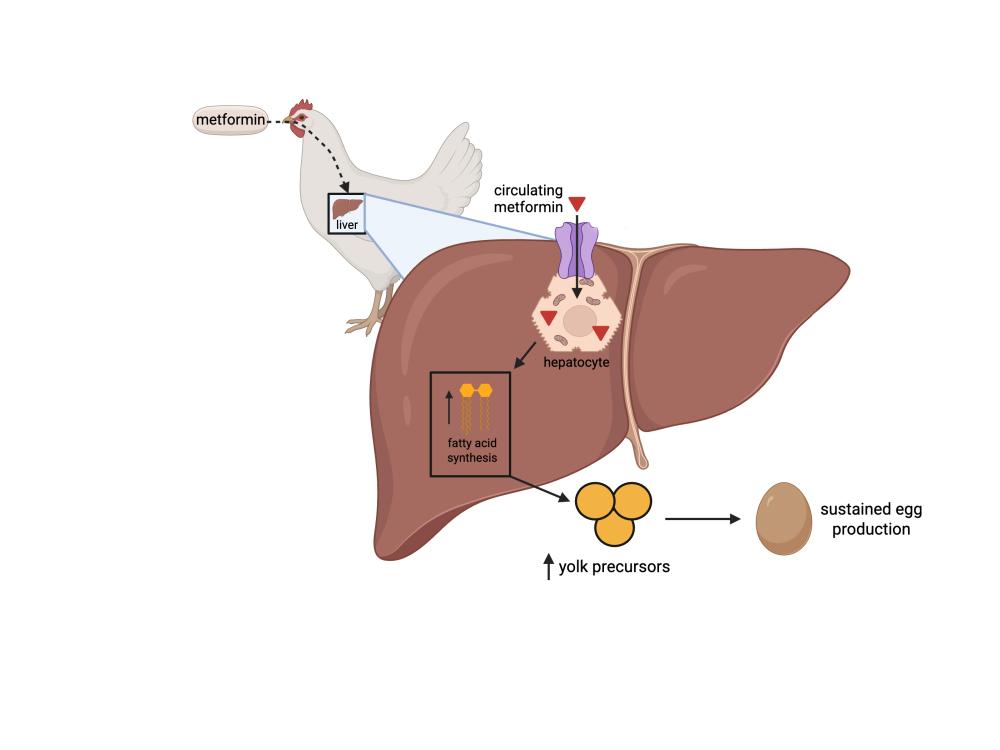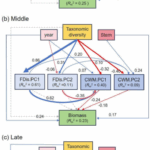2025-05-07 ペンシルベニア州立大学(PennState)
 The liver plays a key role in chicken reproduction, as it’s where egg yolk precursors are made. Metformin “switched on” several genes involved in producing yolk proteins and maintaining stable blood sugar. At the same time, it “switched off” genes linked to fat buildup. Credit: Penn State. Creative Commons
The liver plays a key role in chicken reproduction, as it’s where egg yolk precursors are made. Metformin “switched on” several genes involved in producing yolk proteins and maintaining stable blood sugar. At the same time, it “switched off” genes linked to fat buildup. Credit: Penn State. Creative Commons
<関連情報>
- https://www.psu.edu/news/research/story/common-diabetes-drug-helps-chickens-lay-more-eggs
- https://academic.oup.com/biolreprod/advance-article-abstract/doi/10.1093/biolre/ioaf072/8099357
- https://rep.bioscientifica.com/view/journals/rep/165/3/REP-22-0256.xml
メトホルミンは肝臓の代謝を変化させ、生殖機能を老化させたブロイラー鶏の卵生産を維持する Metformin alters liver metabolism to sustain egg production in the reproductively aging broiler breeder hen
Evelyn Anne Weaver , Nathan Patrick Connolly , Tae Hyun Kim , Ramesh Ramachandran
Biology of Reproduction Published:28 March 2025
DOI:https://doi.org/10.1093/biolre/ioaf072
Abstract
The liver is critical in avian reproduction as it is the primary site of de novo lipogenesis and yolk precursor synthesis. Broiler breeder hens, the parents of commercial broiler chickens, have poor reproductive efficiency due to declining egg production from 45 weeks of age. We found that metformin increases fertile egg production in the aging broiler breeder hen, which was correlated with reduced body weight, reduced fat pad weight, and altered reproductive hormone profiles. This study aimed to characterize the liver transcriptome of the same broiler breeder hens supplemented with metformin in the diet at 0 or 75 mg/kg body weight for 40 weeks (25–65 weeks of age; n = 45 hens/treatment). Liver tissue was collected from a subset of hens (n = 12 hens/treatment group) at 65 weeks of age, and RNA was extracted and sequenced using next-generation sequencing. Differential gene abundance analysis revealed that metformin treatment led to significant changes in gene expression. Further transcriptomic analysis highlighted increased expression of genes related to estrogen-stimulated yolk precursor synthesis, insulin-stimulated de novo lipogenesis, and AMPK-mediated glucose homeostasis. Quantitative PCR analysis revealed increased expression of ESR1, APOB, APOV1, VTG2, ADIPOQ, ADIPOR2, and ACACA mRNA and decreased expression of PCK1 mRNA while plasma triglyceride and non-esterified fatty acid levels were lower in metformin-treated animals compared to controls. The present study suggests that metformin supplementation supports prolonged egg production in aging broiler breeder hens by sustaining yolk precursor and fatty acid synthesis that are typically diminished in aging broiler breeder hens.
メトホルミンは卵巣機能を改善し、ブロイラー飼育鶏の卵生産を増加させる Metformin improves ovarian function and increases egg production in broiler breeder hens
Evelyn A Weaver and Ramesh Ramachandran
Reproduction Published:18 Jan 2023
DOI:https://doi.org/10.1530/REP-22-0256
Abstract
In brief
The pathophysiology of the ovarian dysfunction encountered in broiler breeder hens remains poorly understood but is similar to a condition in women known as polycystic ovary syndrome. This study reveals that metformin may provide a cheap and effective method of improving ovarian function in broiler breeder hens.
Abstract
Broiler breeder hens, the parent stock of commercial broiler chickens, have poor reproductive efficiency associated with aberrant and excessive recruitment of ovarian follicles which results in sub-optimal egg production, fertility, and hatchability. The reproductive dysfunction observed in these hens resembles polycystic ovary syndrome in women, a condition wherein metformin is prescribed as a treatment. The main objectives of this study were to determine the effect of metformin on body weight, abdominal fat pad weight, ovarian function, and plasma steroid hormone concentrations. Broiler breeder hens were treated with 0, 25, 50, or 75 mg/kg body weight of metformin mixed in the diet for 40 weeks (n = 45 hens/treatment; 2565 weeks of age). At 65 weeks of age, hens that received the highest dose of metformin had significantly lower body and abdominal fat pad weights (P < 0.05) than the control. Metformin treatment, at all levels, normalized the preovulatory and prehierarchical ovarian follicular hierarchy. Metformin (50 or 75 mg/kg body weight) significantly increased the total number of eggs laid per hen during the entire production period and these hens had significantly greater fertility and hatchability at 65 weeks of age compared to the control (P < 0.05). Metformin treatment at all levels altered the plasma profile of reproductive hormones, with significantly lower plasma testosterone concentrations and a decreased testosterone to androstenedione ratio in hens that received metformin (P < 0.05). Future studies should focus on the mechanisms underlying the beneficial effects of metformin in improving the reproductive efficiency of broiler breeder hens.



